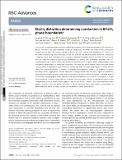Elastic distortion determining conduction in BiFeO3 phase boundaries
Abstract
It is now well-established that boundaries separating tetragonal-like (T) and rhombohedral-like (R) phases in BiFeO3 thin films can show enhanced electrical conductivity. However, the origin of this conductivity remains elusive. Here, we study mixed-phase BiFeO3 thin films, where local populations of T and R can be readily altered using stress and electric fields. We observe that phase boundary electrical conductivity in regions which have undergone stress-writing is significantly greater than in the virgin microstructure. We use high-end electron microscopy techniques to identify key differences between the R–T boundaries present in stress-written and as-grown microstructures, to gain a better understanding of the mechanism responsible for electrical conduction. We find that point defects (and associated mixed valence states) are present in both electrically conducting and non-conducting regions; crucially, in both cases, the spatial distribution of defects is relatively homogeneous: there is no evidence of phase boundary defect aggregation. Atomic resolution imaging reveals that the only significant difference between non-conducting and conducting boundaries is the elastic distortion evident – detailed analysis of localised crystallography shows that the strain accommodation across the R–T boundaries is much more extensive in stress-written than in as-grown microstructures; this has a substantial effect on the straightening of local bonds within regions seen to electrically conduct. This work therefore offers distinct evidence that the elastic distortion is more important than point defect accumulation in determining the phase boundary conduction properties in mixed-phase BiFeO3.
Citation
Holsgrove , K M , Duchamp , M , Moreno , M S , Bernier , N , Naden , A B , Guy , J G M , Browne , N , Gupta , A , Gregg , J M , Kumar , A & Arredondo , M 2020 , ' Elastic distortion determining conduction in BiFeO 3 phase boundaries ' , RSC Advances , vol. 10 , no. 47 , pp. 27954-27960 . https://doi.org/10.1039/d0ra04358c
Publication
RSC Advances
Status
Peer reviewed
ISSN
2046-2069Type
Journal article
Description
K. M. H. and M. A. would like to acknowledge support from the EPSRC through grant no. 1357612. A. K. would like to acknowledge EPSRC support through grant no. EP/N018389/1. K. M. H. and M. A. would like to acknowledge support from ESTEEM2 for funding the experiments carried out at ER-C, Juelich.Collections
Items in the St Andrews Research Repository are protected by copyright, with all rights reserved, unless otherwise indicated.

